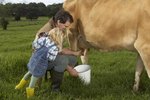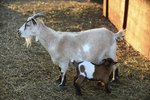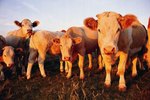
While cows may doze off for a few minutes at a time while standing up, they typically lie down to sleep or simply to rest, usually leaning forward on their chest and forelimbs or lying completely on their sides. Cows need their sleep to stay healthy; just as other animals do -- although they do tend to sleep far less than most of them, including humans.
Standing vs. Lying Down
It's a common misconception that cows don't lie down to rest and that they sleep standing up, just like horses do much of the time. In fact, cows actually lie down for up to 14 hours per day, standing up every few hours, stretching and then lying back down again. While lying down, the cow's hooves get a rest from standing and a chance to dry off from any moisture she's encountered while wandering around. A cow who is lying down can properly digest her food. The blood circulation also increases throughout a cow's udders to help with her milk production while she is in a resting position.
How Much Sleep?
While a cow might spend half the day lying down, she sleeps only a fraction of that time, simply relaxing the rest of the time. Our bovine friends spend around 3.9 hours each day sleeping, which is only 16.4 percent of a 24-hour period. This is half the amount an adult human sleeps each day. Cows usually don't sleep 3.9 hours straight, instead sleeping for shorter periods of time. A cow takes frequent naps throughout the day and especially the night, whch typically last between one and five minutes at a time, according to an article published in the May 2012 issue of "Applied Animal Behaviour Science." The rest of the time they are simply lying down in a drowsy, semi-awake state.
Cow Bedding
Cows need weatherproof stalls filled with soft, comfy material for them to lie on when they sleep. This bedding material must provide your cows with uniform support for their large bodies, stay dry to prevent the growth of pathogens and have a nonabrasive texture that won't scratch their skin. Common bovine bedding materials include paper, sand, compost, sawdust and straw. There are even waterproof cow beds available that are stuffed with soft materials inside, although cows tend to prefer some traditional bedding placed on top of them to lie on. You need to change a cow's bedding frequently to prevent it from becoming dirty and moist, which encourages harmful microorganisms from festering in it.
Sufficient Sleep
To obtain a sufficient amount of rapid eye movement sleep, which is the deepest and most important type of rest, a cow must be able to lie down and have enough room to do so. Cows can't enter REM sleep while standing and this can lead to sleep deprivation. A sleep-deprived cow can become irritable around her handlers and produce less milk. It's best to provide your bovines with enough room for them to lean forward and back in their stalls as they lie down. Give each cow plenty of room to stretch out when lying down, allowing room for their back or front legs to extend outward. This will keep them comfortable and prevent them from becoming sleep deprived.
References
- Manitoba Veterinary Medical Association: Animal MythBusters
- University of Washington -- Eric H. Chudler, Ph.D.: How Much Do Animals Sleep?
- Applied Animal Behaviour Science: Sleep in Dairy Cows Recorded With a Non-Invasive EEG Technique
- MilkProduction.com: Cow Comfort -- Resting
- Domestic Animal Behaviour and Welfare; D. M. Broom, Ph.D. and Andrew Ferguson Fraser
- University of Massachusetts Amherst Agriculture & Landscape Program: Bedding Options for Dairy Cows
- The Prescott Courier: Do Cows Sleep Standing Up or Lying Down?
- New York State Cattle Health Assurance Program: Considerations for Cow Bedding
Resources
Photo Credits
-
Jupiterimages/Photos.com/Getty Images
Writer Bio
Based in Las Vegas, Susan Paretts has been writing since 1998. She writes about many subjects including pets, finances, crafts, food, home improvement, shopping and going green. Her articles, short stories and reviews have appeared on City National Bank's website and on The Noseprint. Paretts holds a Master of Professional Writing from the University of Southern California.




